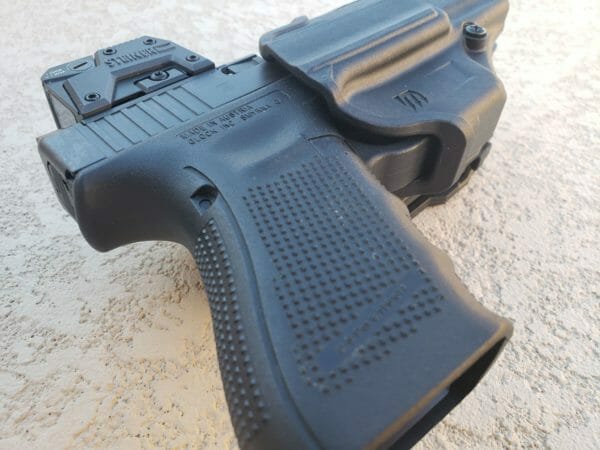
U.S.A. –-(AmmoLand.com)- When Blackhawk first announced the T-Series of holsters, I was a bit surprised. The company’s duty holster selection had been riding on the success of the often maligned SERPA for years without much sign of change. With the new T-Series moving the retention release from the trigger finger to the thumb, my interest was piqued, as this aligns with the designs of many competitors and is widely regarded as a superior location. Curious to see how the T-Series stacked up against my Safariland holsters, I decided to snag a T-Series L2C for myself. How has it held up over the past few years?
Setting the Stage
My perspective on this review is not that of law enforcement or an open carrier, who needs a duty-grade holster. For something like that, you would need a larger sample size and a more consistent testing methodology. Instead, I am viewing this as someone who competes and trains with OWB holsters from time to time. Someone who prefers the features in a duty-style holster, and finds themselves in venues where that is sometimes required. How does the Blackhawk T-Series L2C line up with my expectations?
Construction of the Blackhawk T-Series L2C
The L2C is a bit of an outlier in this series of duty-style holster reviews. While it is still considered “duty rated” by Blackhawk and is made from the same materials as their law enforcement focused L2D line, the L2C is a bit smaller in stature. There are options for weapon mounted light (WML) compatibility, though mine is not one of those. In my mind, and in the marketing, this seems more along the lines of what a plainclothes officer or detective might wear when active retention is still a desire/requirement.

The Blackhawk T-Series L2C is made from injection molded polymer, coming in flat black, and now OD green. My version is designed for the Glock 17, but the open muzzle allows the use of longer slides, such as with my Glock 34. This ensures that any debris entering the holster falls through, avoiding any awkward fishing before putting away the gun. Since retention is based on the trigger guard, I am also able to use shorter pistols such as my Glock 19 as well.
Safety First
The L2C does a fantastic job at protecting the trigger. All angles, whether from the sides or the rear, are fully protected, where even the smallest fingers or bit of debris should find it nearly impossible to interact with the trigger when holstered. Of course the lack of a WML on this specific model aids with that, but fully protected triggers are always nice to see, and not as common as I’d like.
Optics Support
All versions of the Blackhawk T-Series L2C are optics ready, with essentially zero interference across any model of red dot sight (RDS). This is due to the large “Speed Cut” in the front of the holster which clears down to the front of the barrel hood. So far, I’ve tried the L2C with the following optics without issue: Holosun 509T, Aimpoint ACRO, Trijicon RMR, Steiner MPS. The L2C leaves your optic completely exposed, reducing bulk and improving concealment.

While nearly limitless optics compatibility is great, this isn’t without shortcomings. Traditionally, duty style holsters feature some sort of guard to protect optics from environmental hazards. This is especially important if you find yourself grappling with someone on the ground, or in an unconventional shooting position, mashing your optic into the concrete with your entire body weight or more atop it. I don’t consider this to be a big issue with the Blackhawk L2C, merely a tradeoff, but something to be aware of.
Belt Attachment on the Blackhawk T-Series L2C
Blackhawk offers a ton of methods to attach the T-Series L2C to your belt. For the duration of this review I opted to use their Quick Dual Release Belt Loop, which reminds me a bit of a Tek-Lok. Each side of this mount independently locks into place, and the user can easily adjust for different belt widths. It simply snaps into place, and you’re secure.

I won’t go into detail, but there are also options for direct belt loop mounts, drop leg rigs, MOLLE adapters, and more. Most, if not all, of these attachments provide adjustments for ride height and rotation (cant), and are new for the T-Series line.
Retention
As mentioned previously, the Blackhawk T-Series gets retention off of the trigger guard of the pistol. The new release mechanism for these holsters is a medium size, lightly textured lever that is pressed with the inboard with the dominant thumb. This lever is very intuitive, with roughly 90% travel required for the gun to be released. The press is very smooth, with next to no resistance for the user.

If the wearer attempts to pull the gun from the holster prior to pressing the lever, the pistol will remain locked in place, requiring the user to push the gun back down and repeat the process. This can cause some problems under stress, but is not uncommon among retention holsters, and could help in a gun grab. When holstering my pistol, there is both audible and tactile locking from the holster. A quick pull upwards verifies that my gun is secure.
Sword and Shield
The retention release lever is not unprotected. Two large wings flank the release, shielding it from the front and back, only allowing access from above or against the body. This might be the most well protected release I’ve seen to date, which I’m sure is appreciated by those wearing this in a martial sense. As someone coming from Safariland ALS holsters, I did notice that these protective wings would flub my draw. If you’re used to sweeping your thumb downward to defeat retention, you’ll need to change your drawstroke. Stabbing directly downward onto the pistol seems like a better technique, reliably placing my thumb between the wings and onto the release every time.
Passive Aggressive
In addition to the active retention lever on the L2C, Blackhawk has also included passive retention. It is this which brings the holster to level two retention, hence the “2” in “L2C”. Passive retention is adjustable, allowing the user to set their preference. This is done via a phillips head screw located near the front of the trigger guard. I’ve kept mine at the default setting throughout the course of this review.
Range time
In addition to live fire, I’ve done a lot of dry practice with the Blackhawk T-Series L2C. One of my questions was whether or not the more aggressive slide serrations on my Glock 34, or the squared edges of the Brownells G17 slide would impact the performance of the holster. I’ve seen them act like saw blades on some concealment options, and thought they might do the same on the tighter fitting L2C. This has not been the case. Despite hundreds of draws, the holster is no worse for wear.

As part of this review, I’ve done some very rudimentary gun grabs with the L2C. Again, this isn’t for a duty recommendation, but I know people would ask if I didn’t do it. To date, I have not been able to defeat the retention mechanism, even with two hands, nor have I been able to damage the belt hardware. Even with only one side of the Quick Dual Release Belt Loop secured, the holster remained on my belt. Of course a stronger or more aggressive attacker may have better luck, but for training and competition purposes, this is more than sufficient.
My biggest, and really only, gripe thus far is simply a matter of familiarity, and one I’ve mentioned already. I spend significantly more time with IWB holsters than I do duty holsters. On top of that, the vast majority of my experience with duty holsters has been with Safariland ALS variants. Because of this, I am wired to sweep my thumb downwards on the drawstroke. Doing this is not helpful with the T-Series, and deliberate practice is required to learn a new technique. For those jumping into the duty style holster market, you likely won’t have these habits in place, making for an easier transition.
Final Thoughts on the Blackhawk T-Series L2C
Overall I am very pleased with the Blackhawk T-Series L2C, and wouldn’t hesitate to give it a recommendation for those looking for active retention for training, competition, or more. The list of compatible pistols has grown significantly to include options like the 1911, Taurus, Glock 48, Springfield Hellcat, and more, making this one of the only quality options in the category for many makes/models. Retention and construction are solid, and the price is right.
With an MSRP of only $54.99, it’s something that most anyone can afford. Big props to Blackhawk for stepping up and creating a solid holster that fixes some of the problems of their legacy products. You can find yours >>HERE<<
About Dan Reedy
Dan is an Air Force veteran, avid shooter, and dog dad. With a passion for teaching, he holds instructor certifications from Rangemaster, Agile Training & Consulting, and the NRA. He has trained with Darryl Bolke, Mike Pannone, Craig Douglas, among several other instructors, amassing over 400 hours of professional instruction thus far. In his spare time you’ll find him teaching handgun, shotgun, and less lethal classes.
Dan’s work has been published by Primer Peak, and The Kommando Blog, and he has been featured as a guest on Primary & Secondary.
